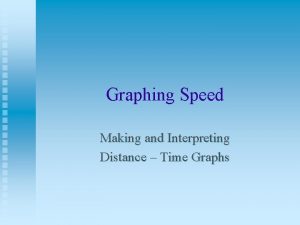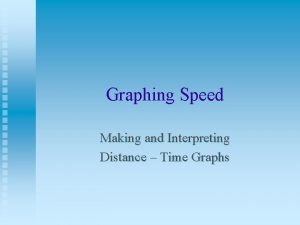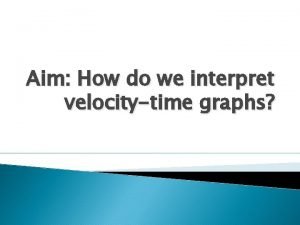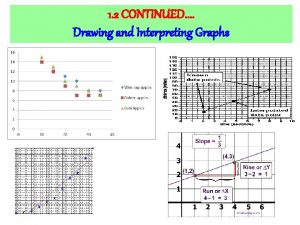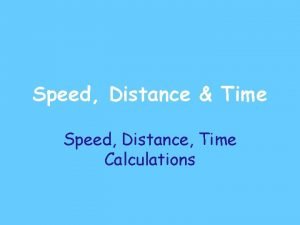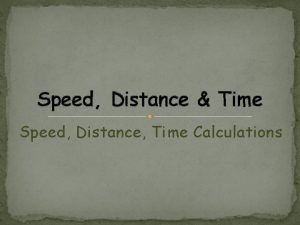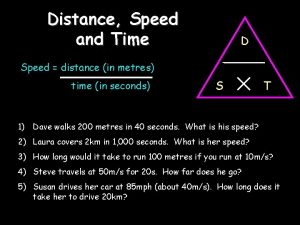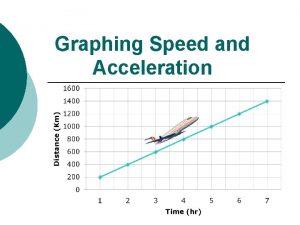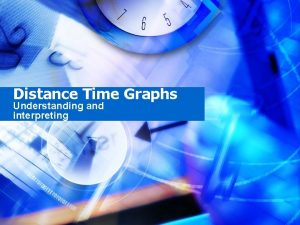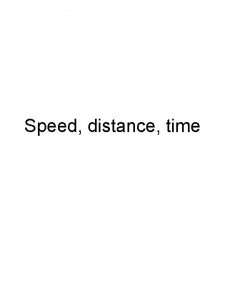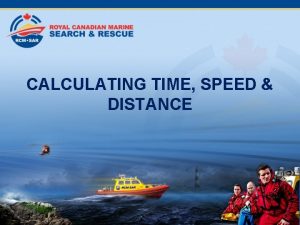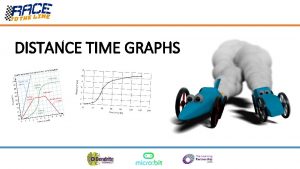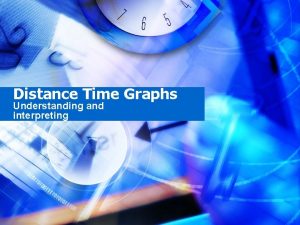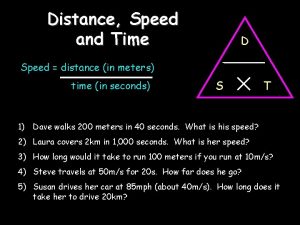Graphing Speed Making and Interpreting Distance Time Graphs
















- Slides: 16

Graphing Speed Making and Interpreting Distance – Time Graphs

GRAPHING SPEED DISTANCE-TIME GRAPHS Distance is plotted on the vertical axis. D I S T A N C E Time is plotted on the horizontal axis. TIME

CONSTANT SPEED If something is “constant” what does that mean? It does not change So… what does the term constant speed mean? Speed that does not change is constant speed. Name some things that you think have constant speed. Think outside the

GRAPHING CONSTANT SPEED DISTANCE-TIME GRAPHS t straight diagonal line d 100 1 20 2 40 3 60 4 80 5 100 90 D I S T A N C E (m) 80 70 60 50 40 30 20 10 0 1 2 3 4 5 TIME (sec) Describe the shape of the line for constant speed

GRAPHING CONSTANT SPEED DISTANCE-TIME GRAPHS How do you know? t d A has the > slope therefore it has the > constant speed. A 100 1 20 2 40 3 60 4 80 5 100 90 D I S T A N C E (m) 80 B 70 60 50 C 40 30 20 10 0 1 2 3 4 5 TIME (sec) Which object has the greatest constant speed?

GRAPHING AVERAGE SPEED DISTANCE-TIME GRAPHS What does this part of the line mean? 100 t d 1 10 2 30 3 40 4 40 5 80 A flat horizontal line means motion stopped. 90 D I S T A N C E (m) 80 70 60 50 40 30 20 10 0 1 2 3 TIME (sec) 4 5 zigzag Describe the shape of the line for average speed?

Average Speed Average speed is speed that changes or fluctuates. Most moving objects travel at average speed, they start from a stand still, begin slowly, increase their speed, slow down, speed up, and eventually slow to a stop. On a distance-time graph average speed would appear as a line that changes direction as it goes across the graph. It would be described as a zig-zag line. A slanted line indicates that motion is occurring. A flat horizontal line indicates that motion has stopped but time continues.

Acceleration In order to understand acceleration you must understand the difference in speed and velocity. Speed is how long it takes a moving object to travel a distance. Velocity is speed in a given direction. NOW, ACCELERATION IS THE RATE OF CHANGE IN VELOCITY. You must understand that if either speed or direction changes, the object has undergone acceleration.

In this diagram, how many times will the people experience acceleration from where they are now to the end of the ride? 1 2 Speeds up ? ? ? Slowing down is also considered to be acceleration. Let’s look at why this might be. Is there any other place that its velocity will change?

GRAPHING ACCELERTION DISTANCE-TIME GRAPHS 100 t 1 d 90 10 2 20 3 40 4 70 5 110 D I S T A N C E (m) 80 70 60 50 40 30 20 10 0 1 2 3 4 5 TIME (sec) Describe the shape of a line showing acceleration.

INTERPRETING DISTANCE-TIME GRAPHS a 100 90 D I S T A N C E (in) c b d 80 70 60 50 40 30 20 10 Pass out question sheet for this slide. 0 1 2 3 TIME (hr) 4 5

Time Construct a distance – time graph for the values in the data table. PASS OUT GRAPH PAPER FOR THIS EXERCISE. (sec) 0 1 2 3 4 5 6 NEATNESS COUNTS ! 7 8 9 10 Total distance covered (meters) A 0 3 6 9 12 15 18 21 24 27 30 B 0 2 4 6 8 10 12 14 16 18 20 C 0 4 8 12 16 16 19 22 25 D 0. 25. 5 1 3 6 10 15 21 28 36

D I S T A N C E (m) TIME (sec) Your graph should look like this.

A few questions for you: 1. What does the horizontal line for car C indicate? It had to stop during a portion of the race 2. Which car(s) is/are accelerating? How do you know? Car D because its line is curving. 3. Which car(s) is/are traveling at constant speed? Cars A and B show straight diagonal lines 4. Which car won the race? Car D because it traveled farther in the 10 seconds 5. How do you know which car won the race? Because it traveled farther in the 10 seconds 6. What is the average speed of each car in the race? A 3 m/s B 2 m/s C 2. 5 m/s D 3. 6 m/s

QUIZ 1. The graph used to graph speed is called a ______-______ graph. 2. Speed that does not change is called ______ speed. 3. Speed that fluctuates is called ________ speed. 4. The shape of a line on a distance-time graph for constant speed is a ________, ________ line. 5. The > the slope the _______ the constant speed. 6. On a distance time graph a line that is horizontal indicates __________. 7. The formula for calculating speed is _____=_____ 8. Speed in a given direction is called _________. 9. The rate of change in velocity is called__________.

The End We hope that you have been able to learn something from us.
 Comparing distance/time graphs to speed/time graphs
Comparing distance/time graphs to speed/time graphs Interpreting distance time graphs
Interpreting distance time graphs Creating and interpreting distance time graph
Creating and interpreting distance time graph Graphing speed
Graphing speed Making science graphs and interpreting data
Making science graphs and interpreting data What is the average velocity of the object
What is the average velocity of the object How to find speed
How to find speed Misleading graph
Misleading graph Speed and velocity venn diagram
Speed and velocity venn diagram Drawing and interpreting graphs
Drawing and interpreting graphs Speed distance and time
Speed distance and time Hiw to calculate speed
Hiw to calculate speed Calculating speed worksheet
Calculating speed worksheet How to convert time to distance
How to convert time to distance Speed distance time calculations
Speed distance time calculations Formula for speed distance and time
Formula for speed distance and time D= speed x time
D= speed x time


